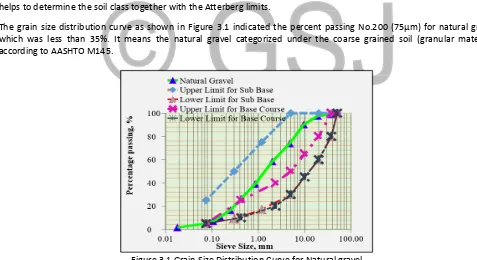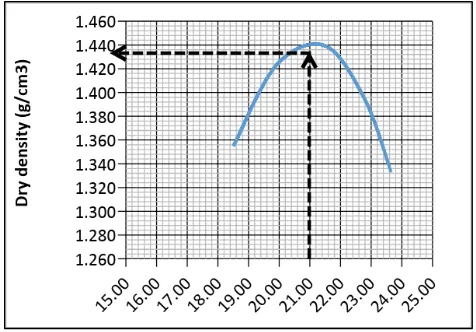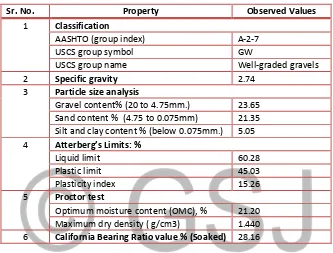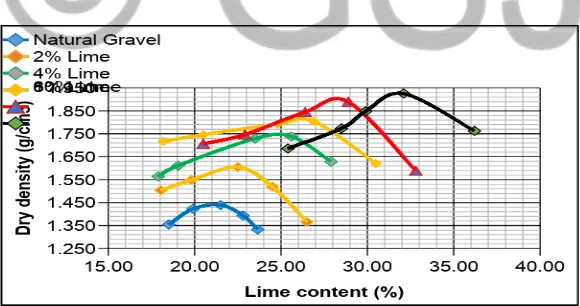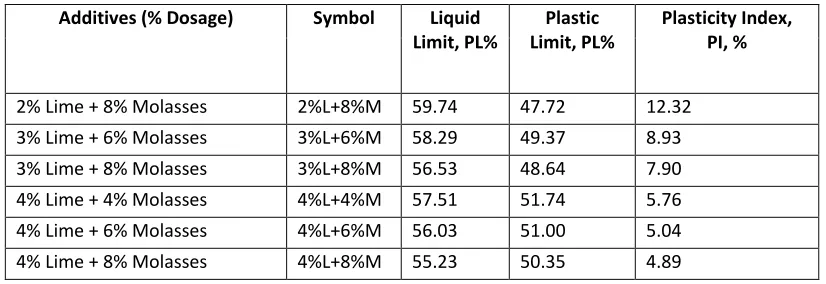GSJ© 2018
GSJ: Volume 6, Issue 7, July 2018, Online: ISSN 2320-9186
www.globalscientificjournal.com
Combined Effects of Molasses-Lime Treatment on Poor
Quality Natural Gravel Materials Used for Sub-Base and
Base Course Construction
Yibas Mamuye1, Emer Tucay Quezon2, Anteneh Geremew3
1
Lecturer, Highway Engineering Stream, Faculty of Civil and Environmental Engineering, Jimma Institute of Technology, Jimma University, Jimma, Ethiopia.
2
Professor, Department of Civil Engineering, Post Graduate Studies, Ambo Institute of Technology, Ambo University, Ambo, Ethiopia.
3
Senior Lecturer and Dean of Continuing and Distance Education, Jimma Institute of Technology, Jimma University, Ethiopia.
Email address:
yibasmom2012@gmail.com (Yibas M.), quezonet09@gmail.com (E. T. Quezon), antjiren@gmail.com (Anteneh G.)
ABSTRACT
At the time of industrial development, production of large amounts of wastage required proper disposal. To reduce the disposal problem, utilization of wastage in construction works is a very important aspect. Reuse of industrial waste had gained high momentum for achieving sustainable waste management locally and globally. Keeping this in mind, a research carried out to assess the utilization of molasses, lime and molasses-lime for improving natural gravel for sub-base and base course construction from Jimma Jiren quarry site. The natural gravel from this quarry site is known to have a poor quality, since it did not satisfy the ERA standard specification for sub-base and base course construction. To use Jiren natural gravel as a sub-base or base course construction material, it is necessary to improve its engineering properties. The laboratory test matrix in each test plan included variations in additive type, additive content, and curing period. It was established 8% cane molasses by weight of dry soil as the maximum for effective stabilization of natural gravel for sub-base construction, but not suitable for a base course layer. Results indicated that the natural gravel specimens from Jiren quarry site stabilized with lime, provided higher CBR values than a molasses used alone. On the other hand, replacing 50% of lime content by molasses indicated better results than the performance of either individual additive. Therefore, the natural gravel blended with molasses-lime combination is much better when it used for sub-base and base course construction to treat such an inferior quality of natural aggregates.
1 INTRODUCTION
The natural gravel deposits do not always possess the requisite engineering properties to serve as qualified geotechnical materials for construction. As a result, well-established techniques of soil stabilization are often used to improve the properties of geotechnical materials through the addition of binding agents *1+. Generally, soil stabilization is concerned with increasing volume stability, strength, and durability. A good road (paved or unpaved) requires a suitable foundation, which in turn requires soil stability. The degree of stability is primarily a function of the road material's resistance to lateral movement or flow *2+. Different types of road material employ different mechanisms for resisting lateral movement. In general, granular soils count on their particle sizes, angularity, and interlocking ability to develop the internal friction required to resist lateral movement. There are many varieties of soil available for road construction. Unfortunately, many of the soil deposits do not naturally possess the requisite engineering properties to serve as a good foundation material for roads and highways. As a result, soil-stabilizing additives or admixtures are used to improve the properties of less-desirable road soils. When used, these stabilizing agents can improve and maintain soil moisture content, increase soil particle cohesion, and serve as cementing and waterproofing agents *3+. The over dependent on the utilization of industrially manufactured soil improving additives, i.e. Cement and lime have kept the cost of construction of stabilized road financially high. Thus the use of industrial waste (such as molasses) will considerably reduce the cost of construction as well as reducing the environmental hazards they cause. Replacing proportions of the Lime in soil stabilization with a secondary cementitious material like molasses will reduce the overall environmental impact of the stabilization process *3+. Molasses is dark, viscous syrup with a bittersweet flavor. It is the by-product of the refining of sugar cane into table sugar. Molasses can be reprocessed in low temperature vacuum pans until the cost of working exceeds the value of the sugar produced. The remaining molasses are discarded as waste *4+. In Jimma area there are three sources of natural gravel, namely Seka, Jiren and Merewa quarry sites. Seka and Merewa quarry sites satisfied the requirement for sub-base and base course construction, but Jiren quarry site did not satisfy the standard specification *5+. Therefore, to use Jiren natural gravel as a sub-base or the base course construction material it is necessary to improve its engineering properties. This research, the natural gravel from Jiren quarry site tried to improve its properties by introducing Molasses, Lime and a combined dosage of Molasses- Lime treatment. Lime was used to improve natural gravel from Jiren quarry site, but it is costly. A molasses are available and cheap which can be used as a replacement or auxiliary additive for lime. Hence, this research identified the suitability of using cane molasses, lime and molasses-lime to improve the engineering properties of natural gravel from Jiren quarry site. To investigate the suitability, a question was formulated as follows: (a) What are the engineering properties of natural gravel material from Jiren quarry site? (b) What optimum dosage of cane molasses, lime and molasses-lime that can be used to stabilize natural gravel material from Jiren quarry site for base course and sub- base construction? (c) What is the best curing number of days for molasses-lime stabilized soil? (d) How much deviation the laboratory test results from the standard specification?
2 RESEARCH METHODOLOGY
2.1 Study area
Jimma town is located 353kms Southwest of Addis Ababa in Oromia Region. It has latitude and longitude of 7°40′N 36°50′E and elevation varies from 1,780m-2000m above sea level. The natural gravel materials used for this research were taken from Jiren quarry sites which is found 7 kms away from Jimma Town.
2.2. Study Design
Experimental study designs were used in this study. It was attempted to conduct laboratory tests sieve analysis, Atterberg limits, Specific gravity, CBR value, and Proctor compaction tests on natural gravel samples treated with different proportions of cane molasses, lime and molasses-lime and checking to standard specification.
2.3 Sampling Procedure
GSJ© 2018 2.4 Study Variables
The study variables are categorized into two. These are dependent variable and independent variables.
Dependent variable
✓ Properties of stabilized base course and sub-base course
Independent Variables
✓ Dosage of molasses, lime and molasses-lime
✓ Engineering properties of natural and stabilized natural gravel, and Curing time
2.5 Data Collection Process
All necessary data was collected from tests undertaken during this research. For each additive, there were four different tests carried out. From these tests, values were taken as input data for the analysis. Each result compared with the ERA standard specifications.
2.5.1 Mass of sample
The minimum mass of the natural gravel sample was taken according to AASHTO T-86.
Table 2.1: Minimum mass of gravel sample required
Sr. No.
Description Minimum mass
Recommended by AASHTO T-86
Minimum mass of gravel sample
1 When the classification test is required. 5kg-120kg 120kg
2 When a compaction test and a single CBR test
are required in addition to classification test. 20kg-40kg 40kg
3 When the additional CBR test is required in
addition to classification test. 5kg-10kg 10kg
4 If treatment test is undertaken. 50kg-100kg 3*100kg
The total mass of gravel sample taken 470kg
2.5.2 Methods of preparation
✓ The bulk sample was taken from the Jimma Jiren quarry site.
✓ To prevent moisture evaporation the natural gravel placed inside the thick-gauge plastic bags.
✓ If the natural moisture content of the sample was higher than desired for mixing, the samples was air-dried to moisture content just below the target value.
✓ Quartering sampling techniques used to quarter the natural gravel sample for four broad categories of treatment types: (1) untreated soil sample, (2) soil sample treated with cane molasses, (3) soil sample treated with lime, and (4) soil sample treated with cane molasses-lime.
✓ Representative samples extracted to determine the property of natural gravel without using any additives. ✓ After obtaining enough soil from the large bulk samples to create one batch of specimens for stabilization,
any particles larger than 5 mm were removed.
✓ The amount of stabilizer added to the mixture and blended thoroughly until it becomes homogeneous. Molasses and lime contents 2%, 4%, 6%, 8%. 10% by weight of natural gravel sample would use in the stabilization. Molasses-lime contents with a varying proportion blended with natural gravel to get maximum effect.
✓ If necessary to achieve the desired moisture content for the batch, additional water blended into the sample and mixed.
2.5.3 Laboratory tests
The experimental tests in this research included the CBR test as a strength property test, Atterberg limits and standard Proctor compaction tests as engineering properties tests. For comparison purposes, the primary experimental plan for the strength property test encompassed preparing and testing four broad categories of treatment types: untreated natural gravel sample, natural gravel sample treated with cane molasses, natural gravel sample treated with lime, and soil sample treated with cane molasses-lime. Natural gravel was mixed with each additive at variable percentages to examine their influence.
Similarly, the moisture contents and curing periods incorporated as variables into the test factorial. The level of water content of the test samples used optimum moisture content of untreated soil. Lastly, the curing period, primarily investigated at 3, 7, and 14 days after sample fabrication for strength tests.
2.5.4 Mixing Procedure
If necessary to achieve the desired moisture content for the batch, additional water blended into the soil and mixed for three to five minutes. After water addition, the appropriate amounts of stabilizer added to the mixture and blended thoroughly for three to five minutes. The water and stabilizer added slowly to promote the uniform blending and to prevent clumping of the soil and the stabilizer.
3 RESULTS AND DISCUSSION
3.1 Engineering properties of Natural Gravel
The result of the test used to determine the particle size distribution with applicable specification requirement and it also helps to determine the soil class together with the Atterberg limits.
The grain size distribution curve as shown in Figure 3.1 indicated the percent passing No.200 (75µm) for natural gravel which was less than 35%. It means the natural gravel categorized under the coarse grained soil (granular material) according to AASHTO M145.
Figure 3.1 Grain Size Distribution Curve for Natural gravel
From Grain Size Distribution Curves of natural gravel grain diameter at 60% passing (D60) was 2.0mm, grain diameter at 30% passing (D30) indicated 0.51mm, and the grain diameter at 10% passing (D10) of 0.13mm. A gravel or sandy soil is described as well graded or poorly graded, depending on the values of two shape parameters known as the coefficient of
uniformity, Cu, and the coefficient of curvature, Cu was 15.4 and 1 respectively from the formula C =
= 1.00.
GSJ© 2018 3.1.1 Atterberg’s Limits
The Liquid Limit and Plastic Limits of soil indicated the water contents of a certain changes in the physical behavior of soil that was being observed. The liquid limit test conducted as per AASHTO T 89 whereas the plastic limit test based AASHTO T 90.
Table 3.2: Atterberg’s Limit test result of natural gravel
Atterberg’s Limit of Specimen
ERA Specification Status for ERA Specifications Sub-Base Base
Course Liquid limit (LL) 60.28%
PI≤12% PI≤6%
Failed for both Sub-Base and Base Course Plastic limit (PL) 45.03%
Plasticity Index (PI)
15.26%
Table 3.2 indicated the representative sample of natural gravel from Jiren quarry did not satisfy the ERA standard specification for Atterberg limit test. From these results, it needs, improvement of the properties to use for road construction as sub-base or base course material.
3.1.2 Soil Classification
Depending on percentage passing 75µm obtained from sieve analysis and liquid limit, plastic limit and plasticity index obtained from Atterberg’s Limit’s test the natural gravel samples classified according to AASHTO, and USCS soil classification. According to the AASHTO soil classification, the natural gravel categorized under A-2-7, while from USCS natural gravel classification, the soil classified as GW.
3.1.3 Compaction Test
The proctor compaction test conducted for the natural gravel under consideration to determine the maximum dry density and optimum moisture content of the soils.
Figure 3.2: Density-Moisture Content Relationship for natural gravel
3.1.5 California Bearing Ratio (CBR) Test
CBR test conducted to determine the strength of a sampled material and how it was behaving when subjected to loading. The OMC and MDD of the samples were used to prepare a specimen for the CBR test after 4 days soaking to consider the unpredictable increase in moisture. Based on test results, the natural soil material indicated 28.16%, and it is under the ERA standard specification. It means, it cannot be used for sub-base and base course construction. ERA specified a material to be used for sub-base should have a minimum CBR value of 30%, and a CBR value of 80% of base course. (Source: ERA 2002).
Table 3.3 Geotechnical Properties of Natural Gravel
Sr. No. Property Observed Values
1 Classification
AASHTO (group index) A-2-7
USCS group symbol GW
USCS group name Well-graded gravels
2 Specific gravity 2.74
3 Particle size analysis
Gravel content% (20 to 4.75mm.) 23.65
Sand content % (4.75 to 0.075mm) 21.35 Silt and clay content % (below 0.075mm.) 5.05 4 Atterberg’s Limits: %
Liquid limit 60.28
Plastic limit 45.03
Plasticity index 15.26
5 Proctor test
Optimum moisture content (OMC), % 21.20
Maximum dry density ( g/cm3) 1.440
6 California Bearing Ratio value % (Soaked) 28.16
3.2 Effects of the addition of Molasses on Natural Gravel
3.2.1 The effect of the addition of Molasses on Atterberg's limit
The effect of molasses addition in varying proportion with natural gravel had been studied, and the variation in consistency limits for various mixes is presented in the following figure.
GSJ© 2018
Results showed that as the percentage of molasses increases the liquid limit and plastic limit also increases. Consequently, the plasticity index decreased, followed by an increased in molasses content. It means, blending natural gravel with molasses did not satisfy the ERA standard specification for base course construction. Increasing the percent dosage by 8% molasses and 10% molasses satisfied the ERA standard specification for sub-base construction.
3.2.2 The effect of the addition of Molasses on Maximum Dry Density
The dry densities of 1.440 g/cm3 to a maximum value of 1.840 g/cm3 attained due to an increase of percent dosage of molasses up to 8% molasses. Thus the materials used to improve the natural gravel found to facilitate the closer packing of the gravel particles and thus increased the maximum dry density. On the other hand, the OMC indicated to decrease from 21.20% to 15.60%. This result could be attributed to the addition of molasses since molasses are a liquid stabilizer.
Figure 3.4 Effect of Molasses Addition on Dry Density and Moisture Content
3.2.4 The effect of the addition of Molasses on CBR value
It was observed that there is a significant improvement in CBR value to increase in molasses content. CBR values from molasses stabilization started reducing when 8% molasses content was reached.
Table 3.4 Effect of Molasses Addition on CBR value and Swell
Additive % dosage
Symbol CBR, % Swell, % ERA Specifications Sub-Base Base course
Natural Gravel NG 28.16 2.21
CBR≥30 CBR≥80
2% Molasses 2%M 31.79 2.98
4% Molasses 4%M 35.99 3.34
6% Molasses 6%M 38.46 3.69
8% Molasses 8%M 43.69 3.98
3.3 The effect of the addition of Lime on Natural Gravel
3.3.1 The result of the addition of Lime on Atterberg's limit
The effect of lime addition with varying dosage in natural gravel had been tested, and the variation in consistency limits for various mixes is presented in Figure 3.5. It is found that as the percentage of lime increases the liquid limit and plastic limit decreases. Consequently, the plasticity index also reduced, followed by an increase in lime content.
Figure 3.5 Effect of Addition of Lime on Atterberg’s Limits
The blending natural gravel with lime indicated it satisfied the ERA standard specification for Sub-base construction. Likewise, for base course construction, the blending of natural gravel with 8% lime and 10% lime respectively, satisfied the ERA standard specification.
3.3.2 The effect of the addition of Lime on Maximum Dry Density
The values for the maximum dry densities indicated a significant increase with the addition of lime from an amount of 1.440 g/cm3 to a maximum value of 1.930 g/cm3 when it was blended with a 10% lime. While the OMC was found out to increase from 21.20% to 32.00% due to water absorption of lime.
Figure 3.6 Effect of Lime Addition on Dry Density and Moisture Content.
3.3.3 The effect of the addition of Lime on CBR value
GSJ© 2018
Table 3.5 Effect of Lime Addition on CBR value and Swell
Additive content
Symbol CBR, % Swell, % ERA Specifications Sub-Base Base course
Natural Gravel NG 28.16 2.21
CBR≥30 CBR≥80
2% Lime 2%L 37.88 1.61
4% Lime 4%L 53.30 1.59
6% Lime 6%L 75.04 1.50
8% Lime 8%L 86.07 1.45
10% Lime 10%L 92.45 1.39
3.3.4 The effect of the addition of Molasses-Lime on Natural Gravel
3.3.4.1 The result of the addition of Molasses-Lime on Maximum Dry Density
The natural gravel blended with 3% lime + 8% molasses and 4% lime + 8% molasses indicated higher maximum dry density value than those provided by natural gravel mixed with 8%M, 2%L, 4% L, 6%L, and 8%L. From these test results, the replacement proportion of lime in soil stabilization molasses reduced the amount of lime required and improved the maximum dry density better than those provided by lime stabilization.
Besides, when 6% lime mixed with natural gravel the maximum dry density increased by 25.69%. Considering 50% of lime replaced by 6% and 8% molasses; blending the soil with 3%L + 6%M and 3%L + 8%M improved the natural gravel maximum dry density by 27.08% and 35.00%, respectively. Hence, blending a soil with 3%L + 8%M instead of 6%L provided 9.31% additional maximum dry density.
On the other hand, when it was mixed 8% lime, the natural gravel provided a maximum dry density of 31.96%. In the same manner, replacing 50% of lime by 4%, 6% and 8% molasses; blending the natural gravel with 4%L + 4%M, 4%L + 6%M and 4%L + 8%M improved the natural soil maximum dry density by 26.53%, 33.47% and 39.03%, respectively. These results indicated when blending natural gravel with 4%L + 8%M instead of 8%L provided with 7.07% additional maximum dry density. 3.3.4.2 The effect of the addition of Molasses-Lime on CBR value
Figure 3.8 variation of CBR for different additives
Based on the results of the CBR value of 28.16% for the natural gravel, when it was added and mixed with 2% lime as an additive, it gave a CBR value of 34.51%. It means, increasing the dosage of lime there was a significant increased in CBR values. However, considering the addition of 8% molasses alone in the natural gravel, it gave a CBR value of 55.15%. This research conducted laboratory tests by blending and intermixing proportions of lime and molasses which were added to the natural gravel. A blend of 2% lime + 8% molasses gave a value of 105.16%, a blend of 3% lime + 6% molasses gave a value of 148.87%, a blend of 3% lime + 8% molasses gave a value of 196.16%, while blend of 4% lime + 4% molasses gave a value of 190.8%, a blend of 4% lime + 6% molasses gave a value of 210.72% and a blend of 4% lime + 8% molasses gave a value of 227.34%. These test results indicated that the natural gravel blended with 3% Lime + 6% Molasses, 3% Lime + 8% Molasses, 4% Lime + 4% Molasses, 4% Lime + 6% Molasses and 4% Lime + 8% Molasses achieved a CBR value increased by 145.81%, 196.16%, 190.84%, 210.72% and 227.34% respectively from the untreated CBR of 28.16%. It was a good indication of an improved property of the natural gravel soil from Jiren quarry.
3.3.4.3 The effect of the addition of Molasses-Lime on Atterberg's limit
The blending natural gravel with molasses-lime satisfied the ERA standard specification for Sub-base construction with 2% Lime + 8% Molasses. For base course construction, the blending natural gravel with 4% Lime + 4% Molasses, 4% Lime + 6% Molasses and 4% Lime + 8% Molasses indicated that it satisfied ERA standard specification.
Table 3.6 Effect of molasses-lime addition to Atterberg’s limit
Additives (% Dosage) Symbol Liquid Limit, PL%
Plastic Limit, PL%
Plasticity Index, PI, %
2% Lime + 8% Molasses 2%L+8%M 59.74 47.72 12.32
3% Lime + 6% Molasses 3%L+6%M 58.29 49.37 8.93
3% Lime + 8% Molasses 3%L+8%M 56.53 48.64 7.90
4% Lime + 4% Molasses 4%L+4%M 57.51 51.74 5.76
4% Lime + 6% Molasses 4%L+6%M 56.03 51.00 5.04
GSJ© 2018
Table 3.7 Suitability of blended material for sub-base and base course construction in wet areas
Additives (% Dosage) Symbol PI, % CBR, % Suitability For sub- base, CBR≥30 & PI≤12
Suitability For base course, CBR≥80 PI≤6
Natural Gravel NG 15.26 28.16 No No
2% Molasses 2%M 14.27 31.79 No No
4% Molasses 4%M 13.26 35.99 No No
6% Molasses 6%M 12.20 38.46 No No
8% Molasses 8%M 11.16 43.69 Yes No
10% Molasses 10%M 10.02 37.16 Yes No
2% Lime 2%L 11.65 37.88 Yes No
4% Lime 4%L 7.03 75.04 Yes No
6% Lime 6%L 5.36 86.07 Yes Yes
8% Lime 8%L 4.44 92.45 Yes Yes
2% Lime + 8% Molasses 2%L+8%M 12.32 57.90 No No
3% Lime + 6% Molasses 3%L+6%M 8.93 69.52 Yes No
3% Lime + 8% Molasses 3%L+8%M 7.90 83.40 Yes No
4% Lime + 4% Molasses 4%L+4%M 5.76 81.90 Yes Yes
4% Lime + 6% Molasses 4%L+6%M 5.04 87.50 Yes Yes
4% Lime + 8% Molasses 4%L+8%M 4.89 92.18 Yes Yes
As per ERA standard specification for arid and semi-arid areas, it is possible to use materials those have a maximum plasticity index of 12% and minimum CBR of 60% for base course construction, and a material those have a maximum plasticity index of 25% and minimum CBR of 30% of sub-base construction.
3.4 Curing Period
This research did not involve an investigation of variations of curing temperature. It means all samples cured at room temperature. The curing period of specimens considered 3 days, 7 days and 14 days in this research. It was analyzed for natural gravel molasses-lime mix which was suitable for subbase or base course construction. The results indicated the natural gravel treated with 4% lime plus 8% molasses achieved 14-days curing of 126.00% CBR. It showed that the resulting value in CBR with an increase of 347.44% from the untreated CBR of 28.16%. Blending natural gravel with 4% lime plus 6% molasses produced somewhat similar results, obtained at 14-days curing with a CBR of 114.53%, which was equated to a CBR increased by 306.71%. The CBR achieved using 4% lime plus 4% molasses after 14-days curing indicated 104.65%, resulting in a 288.49% CBR increased. While, the CBR achieved using 3% lime plus 8% molasses after 14-days curing showed 109.40%, resulting in a 271.63% CBR increased, and Natural gravel treated with 3% lime plus 6% molasses achieved a 14-days curing with a CBR of 99.85%, resulting in a CBR increased of 254.58% percent from the untreated CBR of 28.16%.
4 CONCLUSION
Based on the results obtained from the experimental investigation, the following conclusions have been drawn.
The natural gravel extracted from Jiren quarry site was not suitable for use as sub-base and base course material for road construction because it did not satisfy the requirements as per ERA Standard Specifications. The addition of 8% molasses in the natural gravel material from Jiren quarry site indicated suitable for sub-base construction, but not suitable as a stabilizer for base course. The addition of a minimum 2% lime in the natural gravel taken from Jiren quarry site was suitable for sub-base construction. On the other hand, replacing 50% of 8% lime with 4% molasses, 6% molasses or 8% molasses (4% Lime + 4% Molasses, 4% Lime + 6% Molasses and 4% Lime + 8% Molasses) produced adequate strength for base course construction.
Molasses alone cannot be used effectively to improve the natural gravel for use in base course construction. However, molasses can be used as an additive to lime in varying amounts which can provide satisfactory results meeting the required standards.
The blending of 6% lime with natural gravel increases the CBR by 205.64% Replacing 50% of 6% lime by 6% molasses and 8% molasses; blending the soil with 3%L + 6%M and 3%L + 8%M improved the natural gravel CBR by and 146.87% and 196.16% respectively. Further analysis, showed that blending 8% lime with natural gravel increased the CBR by 228.30%. Replacing 50% of 8% lime by 4% molasses, 6% molasses and 8% molasses; blending the natural gravel with 4%L + 4%M, 4%L + 6%M and 4%L + 8%M improved the natural gravel CBR by 190.84%, 210.72% and 227.34% respectively.
Finally, it is known that the curing process plays an important role in the development of strength of molasses-lime stabilized natural gravel. The increase in CBR value corresponded to the blend of natural gravel with 4% lime plus 8% molasses after 14 days of curing found to be 347.44%. The natural gravel treated with molasses-lime achieved an average of 293.8 percent CBR after 14-days curing of the untreated CBR of 28.16%. The CBR of the molasses-lime treated natural gravel at a curing time of 3 days achieved an average CBR about 81% of the 14 days curing, and at a curing time of 7 days achieved an average CBR about 95.62% of the 14 days curing period.
ACKNOWLEDGMENT
The authors wish to thank the Jimma Institute of Technology, Jimma University for sponsoring this research.
—————————— ◆ ——————————
REFERENCES
[1] Basha, E. A., R. Hashim, H. B. Mahmud, and A. S. Muntohar (2005). Stabilization of Residual Soil with Rice Husk Ash and Cement. Construction and Building Materials, Vol. 19, pp. 448–453.
[2] ARBA. American Road Builders (1996), Materials for Stabilization, Washington, D.C.
[3] Gow, A. J., D. T. Davidson, and J. B. Sheeler (2001). Relative Effects of Chlorides, Lignosulfonates and Molasses on Properties of a Soil-Aggregate Mix. In Highway Research Record 282, HRB, National Research Council, Washington, D.C., pp. 66–83.
[4] Suriadi, A., Murray, R. S., Grant, C. D. & Nelson, P. N. (2002) Structural stability of sodic soils in by gypsum and molasses. Australian Journal of Experimental Agriculture, 42: 315-322.
[5] Almaz Ejeta, Emer Tucay Quezon, Habtamu Getachew (2017). Engineering Properties of Mechanically Stabilized Subbase Material Using Natural Gravel around Jimma Quarry Sites for Unpaved Road Construction; Global Scientific Journals: Vol 5, Issue 5, pp. 93-102.
[6] Ethiopian Road Authority (2002), Pavement Design Manual, Flexible Pavements, and Gravel Roads, Unbound Pavement Materials, Addis Ababa.
[7] Little, D.N (1995). Handbook for Stabilization of Pavement Subgrades and Base Courses with Lime. Kendall/Hunt, Iowa.
[8] Joint Departments of the Army and Air Force (JDAAF) (1994). Soil stabilization for pavements, TM 5-822-14/AFMAN 32-8010, Washington, DC.
GSJ© 2018
[10] Air Force Civil Engineer, (2012). Military Soils Engineering. Chapter 9, Soil Stabilization for Roads and Airfields. Field Manual, 5-410p.
[11] National lime association (2004). Lime stabilization and lime modification. Published report.41p.
[12] American Road Builders Association, (2004). Lime-treated Soil Construction Manual. Published report. 40p.
[13] Bulbul A., Abdul A., Abu S. (2013). Improvement of Soil Strength Using Cement and Lime Admixtures. Earth Science. 2 (6): 139-144.
[14] Miura N., Horpibulsuk S., and Nagaraj T.S. (2002). Engineering behavior of cement stabilized clay at high water content. Soils and Foundations, Japan Geotechnical Society (JGS). 41(5): 33-45.
[15] Hassnen M. J. (2013). Stabilization of Soft Soils Using Salts of Chloride. Journal of Babylon University/Engineering Sciences/ No.(5)/ Vol.(21).
[16] Tamadher T.A., Anuar B.K., Zamri B.C. (2007). Stabilization of Silty Clay Soil using Chloride Compounds. Engineering Science and Technology. 2(1):102-110.
[17] M’Ndegwa, J.K. (2011). The Effect of Cane Molasses on the strength of Expansive Clay Soil. Emerging Trends in Engineering and Applied Sciences. 2 (6): 1034-104.
[18] O’Neill J.M. (2011). Molasses used in the cleanup of polluted sites. Published report. North Jersey.
[19] ASTM D 422-63, 2002. Standard Test Method for Particle-Size Analysis of Soils. Annual Book of ASTM Standards, Vol. 04.08, West Conshohocken, PA.
[20] ASTM D 558-96, 2002. Standard Test Methods for Moisture-Density Relations of Soil-Cement Mixes. Annual Book of ASTM Standards, Vol. 04.08, West Conshohocken, PA.
[21] ASTM D 4318-00, 2002. Standard Test Methods for Liquid Limit, Plastic Limit, and Plasticity Index of Soils. Annual Book of ASTM Standards, Vol. 04.08, West Conshohocken, PA.

